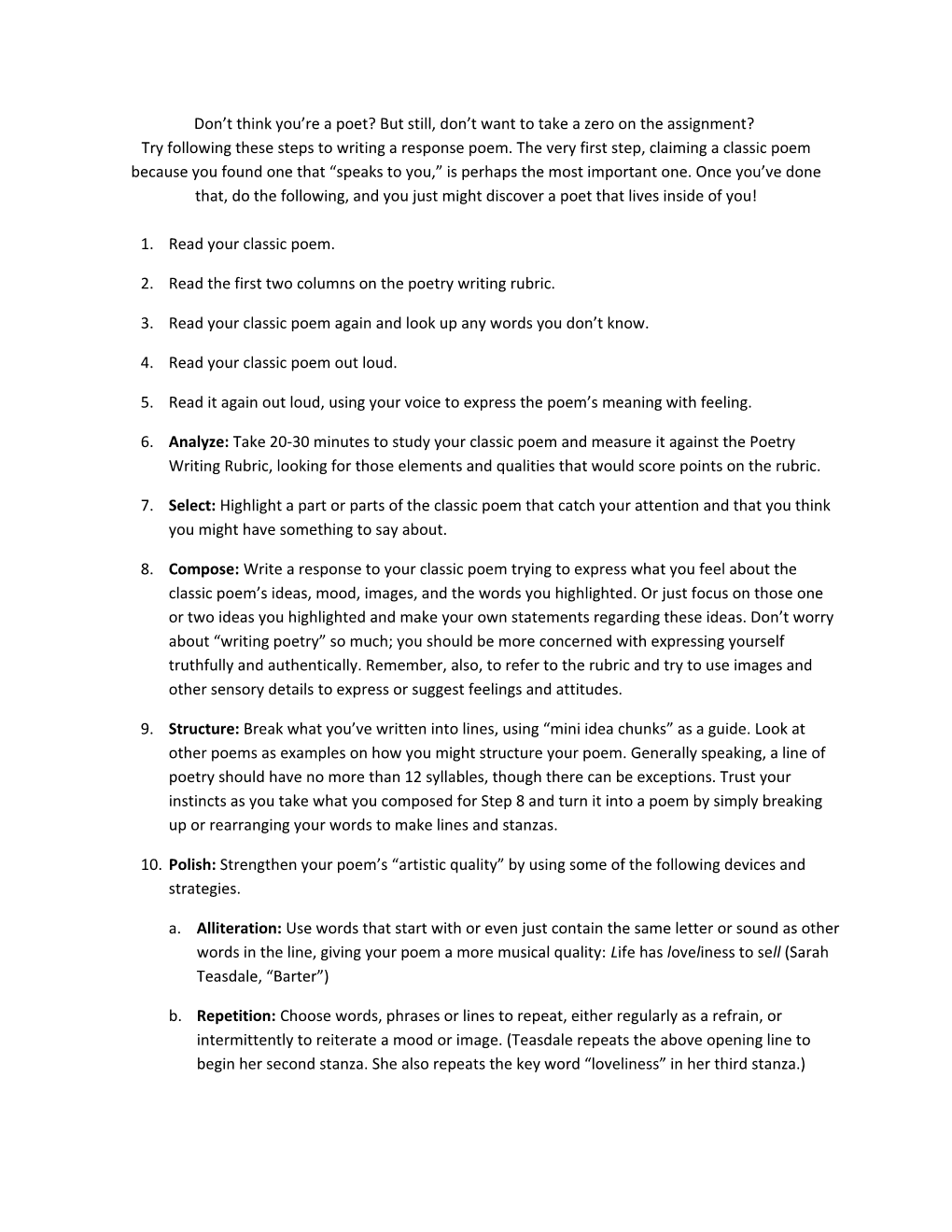Don’t think you’re a poet? But still, don’t want to take a zero on the assignment?
Try following these steps to writing a response poem. The very first step, claiming a classic poem because you found one that “speaks to you,” is perhaps the most important one. Once you’ve done that, do the following, and you just might discover a poet that lives inside of you!
- Read your classic poem.
- Read the first two columns on the poetry writing rubric.
- Read your classic poem again and look up any words you don’t know.
- Read your classic poem out loud.
- Read it again out loud, using your voice to express the poem’s meaning with feeling.
- Analyze:Take 20-30 minutes to study your classic poem and measure it against the Poetry Writing Rubric, looking for those elements and qualities that would score points on the rubric.
- Select: Highlight a part or parts of the classic poem that catch your attention and that you think you might have something to say about.
- Compose: Write a response to your classic poem trying to express what you feel about the classic poem’s ideas, mood, images, and the words you highlighted. Or just focus on those one or two ideas you highlighted and make your own statements regarding these ideas. Don’t worry about “writing poetry” so much; you should be more concerned with expressing yourself truthfully and authentically. Remember, also, to refer to the rubric and try to use images and other sensory details to express or suggest feelings and attitudes.
- Structure: Break what you’ve written into lines, using “mini idea chunks” as a guide. Look at other poems as examples on how you might structure your poem. Generally speaking, a line of poetry should have no more than 12 syllables, though there can be exceptions. Trust your instincts as you take what you composed for Step 8 and turn it into a poem by simply breaking up or rearranging your words to make lines and stanzas.
- Polish: Strengthen your poem’s “artistic quality” by using some of the following devices and strategies.
- Alliteration: Use words that start with or even just contain the same letter or sound as other words in the line, giving your poem a more musical quality: Life has loveliness to sell(Sarah Teasdale, “Barter”)
- Repetition: Choose words, phrases or lines to repeat, either regularly as a refrain, or intermittently to reiterate a mood or image. (Teasdale repeats the above opening line to begin her second stanza. She also repeats the key word “loveliness” in her third stanza.)
- Rhyme: Use rhyme smartly to bring emphasis and produce a poetic “feel.” Even if your poem does not have a definite rhyme scheme, rhyming words placed near each other call special attention to these words and the ideas they carry.
- Economy: Pare your poem down by getting rid of any unnecessary words. Example: Life offers many things that are beautiful that we can enjoy when we make an effort to see them can get pared down to Life has loveliness to sell, which essentially says the same thing, only it’s shorter, and, in many ways, better!
When Teasdale personifies life, for example, by saying it has loveliness to sell, she helps her reader consider life as a bartering agent, that somehow we play a trading game with life as though it is a person. She has come up with a creative way to engage her reader’s imagination, and to make us think about life in new ways.Often just trying to say the same thing in fewer words produces strong, poetic writing that invites the poet—and her readers—to share fresh ways of looking at things.
Teasdale’s poem’s structure is fairly simple: Three sestets (six-line stanzas) with each stanza carrying the same rhyme scheme: abcbdd. Her use of rhyme gives her poem a lyrical (musical) quality, and the couplets (two juxtaposed rhyming lines) that end each of the stanzas call special attention to what these two lines say.
These are just a few of the tools a writer can use, and that Teasdale uses well.
Barter
BYSARA TEASDALE
Life has loveliness to sell,
All beautiful and splendid things,
Blue waves whitened on a cliff,
Soaring fire that sways and sings,
And children's faces looking up
Holding wonder like a cup.
Life has loveliness to sell,
Music like a curve of gold,
Scent of pine trees in the rain,
Eyes that love you, arms that hold,
And for your spirit's still delight,
Holy thoughts that star the night.
Spend all you have for loveliness,
Buy it and never count the cost;
For one white singing hour of peace
Count many a year of strife well lost,
And for a breath of ecstasy
Give all you have been, or could be.
So, suspend your lack of confidence in yourself as a poet long enough to follow the ten steps outlined above. If you do, you may or may not produce spectacular poetry, but you won’t have to take a zero on the assignment, either.
